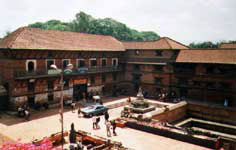|
Kumari:
The crowned goddess
|
 |
 |
| One
of the unique features of Nepal is the institution of Kumari or the
Living Goddess. She lives in her own residence near Kathmandu Durbar
Square and is worshipped by many devotees. She is also called the Royal
Kumari as the King of Nepal receives blessings from her during Indra
Jatra in September. But there is another Kumari in Patan or Lalitpur.
She may not be as famous as the Kumari in Kathmandu, but she has an important
role to play during festivals in Patan. |
|
On the 6th of April I had a chance
to see the selection of Patan's new Kumari.
A
group of people from Patan had come to the home of Badagurujyu of Nepal
accompanied by three candidates for the post of Kumari. A few days earlier,
the present Kumari of Patan, Chandrashila Bajracharya aged nine and a half
years old, had her period and was no longer eligible to be a living goddess
as she had shed blood. A new Kumari had to be urgently selected as important
rituals were necessary for the worship of Machhendranath in Patan.
The
former Kumari was selected when she was only one and half years old in
B.S 1993. Her Kumariship lasted for eight years. There are similarities
in the institution of Kumari in both the cities of Kathmandu and Patan.
Both are ineligible to remain Kumaris after menstruation. However, the
process of selection is somewhat different. The Pujari of Taleju temple
in Patan Durbar Square, a Newari speaking Rajopadhyay Brahmin, shortlists
the candidates based on rituals. I was told there were about ten to start
with.
Unlike Kathmandu, where the Kumari comes from Shakyas, Patan's Kumaris
must come from the family of Bajracharyas, the priests of Buddhist Newars.
It was interesting to note that they were required to come from Ratnakar
Mahavihar in Patan, situated near Gabahal southwest of Patan Durbar Square.
There were three candidates left who had come to the home of Badagurujyu
where the final selection was to be made. One girl was six years old, another
was two and the third was barely a year and half. Badagurujyu's wife was
to interview the three girls and recommend one to be the "Living Goddess".
The parents of the girls were also there, the Pujari of Patan's Taleju
temple and representatives from the Guthi Sansthan who had come to witness
the selection. All three were interviewed and the recommendation for the
installation of Patan's new Kumari was made. It was the eldest of the three,
Sanira Bajracharya who was selected. She is six years old. Her aunt had
also been a Kumari at one time. Her father is a good painter. Some rituals
still needed to be performed before she was to be installed in her house
in Patan. As I was present when the final selection was made, I felt I
was watching the making of history in an ancient ritual. Ancient rituals
are sill alive in the Kathmandu Valley and the institution of Kumari itself
is indicative of this reality which has prompted some foreigners to call
Nepal a "living museum". The Kumari is then worshipped by Newars and non-Newars,
Hindus and Buddhists.
|




